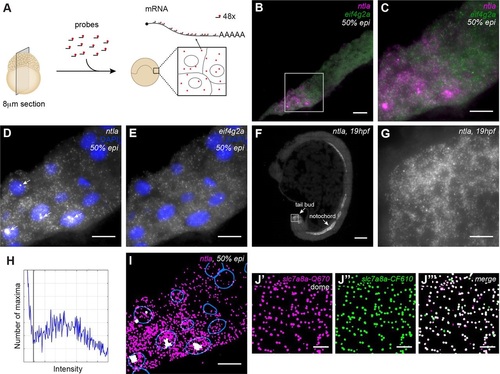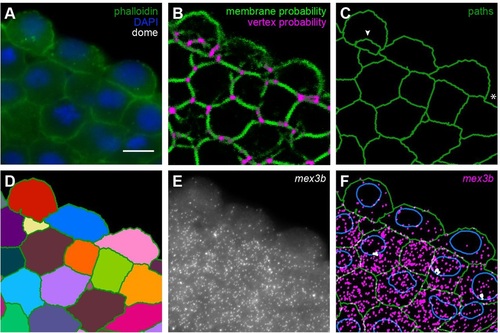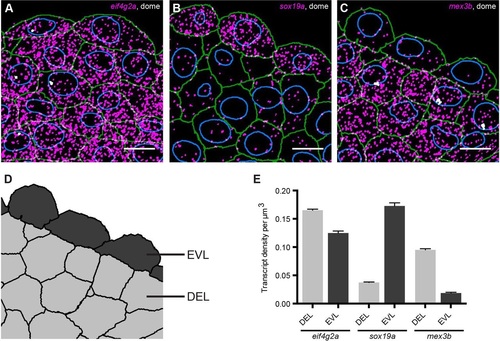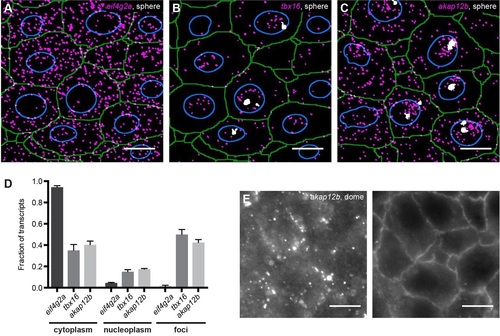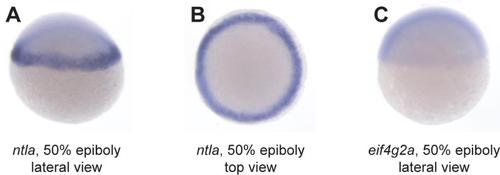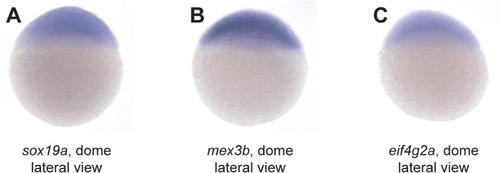- Title
-
Automated detection and quantification of single RNAs at cellular resolution in zebrafish embryos
- Authors
- Stapel, L.C., Lombardot, B., Broaddus, C., Kainmueller, D., Jug, F., Myers, E.W., Vastenhouw, N.L.
- Source
- Full text @ Development
|
Sensitive and specific detection of transcripts and transcription foci in zebrafish sections with smFISH. (A) Overview of smFISH method on sections of zebrafish embryos. (B) smFISH for ntla and eif4g2a on a cryosection of a 50% epiboly stage embryo. Scale bar: 20Ám. Complete animal cap in Fig. S1A. (C-E) Box in B at higher magnification. Scale bars: 10Ám. (C) Dual-color smFISH for ntla (magenta) and eif4g2a (green). (D) smFISH for ntla. Arrows indicate transcription foci. (E) smFISH for eif4g2a. (F) smFISH for ntla on a 19hpf embryo. Scale bar: 100Ám. (G) Detail of F, showing smFISH for ntla in the tail bud. Scale bar: 10Ám. (H) Spot intensity plot for ntla smFISH on the complete animal cap shown in Fig. S1A. Black line indicates transcript detection threshold. (I) Detection of ntla transcripts (magenta) and foci (white) with the Transcript analysis plugin. Nuclear outlines are indicated in blue. Scale bar: 20Ám. (J) Dual-color detection of slc7a8a with two non-overlapping, differently labeled probe sets. Scale bars: 5Ám. (J′) smFISH slc7a8a-Quasar670. (J′′) smFISH slc7a8a-CalFluor610. (J′′′) Dual-color view of transcripts detected with the two non-overlapping probe sets in J′ and J′′. Images are maximum projections of 17 z-slices spaced by 0.3Ám. EXPRESSION / LABELING:
|
|
Automated membrane detection to assign transcripts to cells and nuclei. (A) Phalloidin staining (green) and DAPI staining (blue) on an smFISH sample to identify cell membrane and nuclei. (B) Output of the Cascaded Random Forest classification for membrane (green) and vertex points (magenta) performed on A. (C) Membrane traces (green) generated with the PathFinder tool, using the classified membrane and the vertex points from B as input. Arrowhead indicates over-segmentation, asterisk indicates under-segmentation. (D) Cell mask after manual correction of membrane traces. (E) smFISH for mex3b. (F) Combined detection of transcripts (magenta), transcription foci (white), outlines of cells (green) and nuclei (blue). Scale bar: 10Ám. |
|
smFISH provides quantitative spatial information on gene expression. Detected transcripts (magenta) and transcription foci (white) for sox19a (A), mex3b (B) and eif4g2a (C) at dome stage. Green, cell outlines; blue, nuclear outlines. Scale bars: 10Ám. Images are maximum projections of 17 z-slices spaced by 0.3Ám. (D) Tissue mask corresponding to C, to distinguish between EVL and DEL cells. (E) Quantification of transcript levels in DEL and EVL. Values are means from sections of three different embryos. Error bars represent s.e.m. EXPRESSION / LABELING:
|
|
smFISH provides quantitative subcellular information on gene expression. Detected transcripts (magenta) and transcription foci (white) for eif4g2a (A), tbx16 (B) and akap12b (C) at sphere stage. Green, cell outlines; blue, nuclear outlines. Scale bars: 10Ám. Images are maximum projections of 17 z-slices spaced by 0.3Ám. (D) Single transcript quantification. Values are averages from sections of three different embryos. Error bars represent s.e.m. (E) smFISH for akap12b (left) with corresponding membrane staining for Phalloidin (right) at dome stage. Images are single z-slices. Scale bars: 10 Ám. EXPRESSION / LABELING:
|
|
smFISH for ntla and eif4g2a at 50% epiboly. (A) smFISH for ntla and eif4g2a on a cross-section of an embryo at 50% epiboly showing the complete view of the animal cap shown in Fig. 1A. ntla is expressed in the margin. eif4g2a is ubiquitously expressed. Box 1: region depicted in Figs 1B-D. Box 2: region depicted in Fig. S2B. Scale bar: 50 Ám. (B) Detail of (A) showing the absence of ntla transcripts at the animal pole. Scale bar: 10 Ám. Images are maximum projections of 17 z-slices spaced by 0.3 Ám. |
|
Whole mount in situ hybridization for ntla and eif4g2a at 50% epiboly.(A,B) Whole mount in situ hybridization for ntla at 50% epiboly stage, lateral view (A) and top view (B). ntla is expressed in the margin of the embryo. (C) Whole mount in situ hybridization for eif4g2a at 50% epiboly stage, side view. eif4g2a is ubiquitously expressed. |
|
Dual color detection of ntla and eif4g2a by smFISH does not display overlap. Dual color detection of transcripts for ntla (A) and eif4g2a (B) in a single z-slice of Fig. 1B. (C) Merged image of the detections in (A) and (B). Transcript detection of the two probe sets does not overlap, indicating the specificity of our smFISH protocol. Scale bars: 10 Ám. |
|
Original smFISH images corresponding to Fig. 3. sox19a (A), mex3b (B) and eif4g2a (C) at dome stage. Green, cell outlines; blue, nuclear outlines. Scale bars: 10 Ám. smFISH detections are maximum projections of 17 z-slices spaced by 0.3 Ám. |
|
Whole mount in situ hybridization for sox19a, mex3b and eif4g2a at dome stage. Whole mount in situ hybridization for sox19a (A), mex3b (B) and eif4g2a (C) at dome stage does not detect differences in expression levels between the enveloping layer (EVL) and the deep layer (DEL). |
|
Original smFISH images corresponding to Fig. 4. eif4g2a (A), tbx16 (B), and akap12b (C) at sphere stage. Green, cell outlines; blue, nuclear outlines. Scale bars: 10 Ám. smFISH detections are maximum projections of 17 z-slices spaced by 0.3 Ám. |

